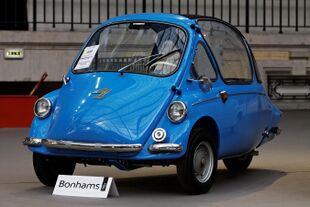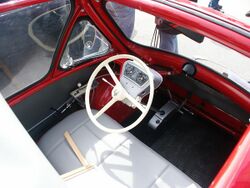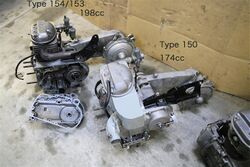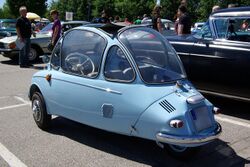Engineering:Heinkel Kabine
| Heinkel Kabine | |
|---|---|
 | |
| Overview | |
| Manufacturer | Heinkel Flugzeugwerke (1956–58)[1] Dundalk Engineering Company (Ireland, 1958)[1] Trojan (UK, 1960–66)[2] Los Cedros S.A. (Argentina, 1960–65) |
| Also called | Trojan 200 |
| Body and chassis | |
| Class | Microcar |
| Body style | One-door sedan |
| Layout | RMR layout, three- or four-wheels[1] |
| Powertrain | |
| Engine | Heinkel four-stroke single-cylinder engine |
| Transmission | 4-speed plus reverse. |
| Dimensions | |
| Length | 2,550 mm (100.4 in)[3] |
| Width | 1,370 mm (53.9 in)[3] |
| Height | 1,320 mm (52.0 in)[3] |
| us|uk|Kerb|Curb}} weight | 243 kg (535.7 lb)[3] |
The Heinkel Kabine was a microcar designed by Heinkel Flugzeugwerke and built by them from 1956 to 1958. Production was transferred under licence to Dundalk Engineering Company in Ireland in 1958. However, the licence was withdrawn shortly afterwards due to poor quality control.[1] Production restarted in 1960, again under licence, under the Trojan 200 name by Trojan Cars Ltd. in the UK, and continued until 1966.[2]
Heinkel Kabines were also assembled under licence by Los Cedros S.A. from 1959 until 1962.[4][5] As Heinkel in Argentina, they were built alongside Studebaker pickups.
The Kabine Model 150 used the 174 cc 9.2 hp single-cylinder four-stroke engine that powered the Heinkel Tourist scooter.[6] In October 1956, Heinkel introduced the Kabine Model 153 (with three wheels) and the Kabine Model 154 (with four wheels), both with 204 cc engines. The engines in these models were later reduced in capacity to 198 cc for insurance purposes.[1]
The Kabine had a steel unit body.[1] Access to the interior was by an opening front. In order not to infringe Iso Rivolta's patent used on the Isetta, the steering wheel did not hinge outwards with the door to ease passenger access. However, it did feature a reverse gear, unlike some other bubble cars. The fabric sun roof served as an emergency escape hatch should the sole door in front become jammed in a collision.
The Kabine featured prominently in the 1959 film I'm All Right Jack and the 1961 film Murder in Eden, and was briefly featured in the 1957 films Blue Murder at St Trinian's and The Naked Truth (aka Your Past Is Showing).
"Kabine" is the German word for "cabin".
Specifications
| Type: | 175 Typ 153 | 200 Typ 154 | 200 Typ 154 | |
|---|---|---|---|---|
| Production dates | 1956–57 | 1956 | 1957–58 | |
| Engine | 1-cylinder air-cooled 4-stroke | |||
| Valvetrain | overhead valve (ohv) | |||
| Bore x stroke | 60 mm (2.4 in) x 61.5 mm (2.4 in) | 65 mm (2.6 in) x 61.5 mm (2.4 in) | 64 mm (2.5 in) x 61.5 mm (2.4 in) | |
| Displacement | 174 cc | 204 cc | 198 cc | |
| Power | 6.8 kW (9.2 PS; 9.1 hp) at 5500 rpm |
7.4 kW (10.1 PS; 9.9 hp) at 5500 rpm |
7.4 kW (10.1 PS; 9.9 hp) at 5500 rpm | |
| Maximum torque | 12.9 N⋅m (9.5 lb⋅ft) at 4450 rpm | 13.2 N⋅m (9.7 lb⋅ft) at 4700 rpm | 13.2 N⋅m (9.7 lb⋅ft) at 4700 rpm | |
| Compression | 7.4 : 1 | 6.8 : 1 | 6.8 : 1 | |
| Electrical | 12 volt | |||
| Transmission | 4-speed shifter at the left side (Kulissenschaltung) | |||
| Structure | "Motocoupé" with front door | |||
| Curb weight | 250 kg (551 lb) | 290 kg (639 lb) | 290 kg (639 lb) | |
| GVWR | 475 kg (1,047 lb) | 510 kg (1,124 lb) | 510 kg (1,124 lb) | |
| Length x width x height | 2550 x 1370 x 1,320 mm (52.0 in) | |||
| Wheelbase | 1,760 mm (69.3 in) | |||
| Track front/rear | 1225 mm / 0 | 1225 mm / 220 mm | 1225 mm / 220 mm | |
| Turning radius | 8,5 m | |||
| Tire size | 4.40–10" | 4.40–10" | 4.40–10" | |
| Fuel economy | ca. 4 L/100 km | |||
| Top speed | 87 km/h (54 mph) | 90 km/h (56 mph) | 90 km/h (56 mph) | |
See also
References
- ↑ 1.0 1.1 1.2 1.3 1.4 1.5 "Bruce Weiner Microcar Museum: 1956 Heinkel Kabine". Microcarmuseum.com. Archived from the original on 3 October 2008. https://web.archive.org/web/20081003013728/http://www.microcarmuseum.com/tour/heinkel.html.
- ↑ 2.0 2.1 "Bruce Weiner Microcar Museum: 1963 Trojan 200". Microcarmuseum.com. Archived from the original on 25 October 2008. https://web.archive.org/web/20081025085347/http://www.microcarmuseum.com/tour/trojan.html.
- ↑ 3.0 3.1 3.2 3.3 "Technical specifications of 1957 Heinkel Kabine". Carfolio.com. http://www.carfolio.com/specifications/models/car/?car=89232.
- ↑ "Scooter and Microcar Club of Argentina: Microcar's History". Microautos.com.ar. http://www.microautos.com.ar/history.html.
- ↑ "HeinkelTrojan Club Newsletter: Editorial Ramblings – Argentinean Production". Heinkel-trojan-club.co.uk. http://www.heinkel-trojan-club.co.uk/newsletter.htm.
- ↑ "Cabin Cruisers". Heinkel Trojan Club. http://www.heinkel-trojan-club.co.uk/cabin_cruisers.htm. Retrieved 9 December 2011.
 |




